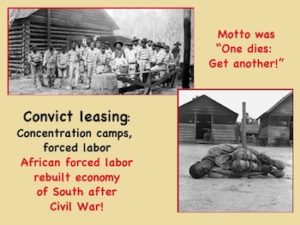
*On this date in 1908, the American Convict Leasing Program began. This system of forced penal labor was practiced in the Southern United States and overwhelmingly involved Black men and boys at the end of the Reconstruction era.
On this date, Green Cottenham (a Black man) was arrested by the sheriff of Shelby County, Alabama, and charged with "vagrancy." Cottenham had committed no actual crime. Vagrancy is the offense of a person being unable to prove at a given moment that they are employed. This was a new and flimsy concoction dredged from legal obscurity at the end of the nineteenth century by the state legislatures of Alabama and other southern states. He was convicted and leased to the Tennessee Coal and Iron Company as prisoner labor.
The program works with private parties, such as plantation owners and corporations like the Tennessee Coal and Iron Company, Chattahoochee Brick Company, etc. The lessee was responsible for feeding, clothing, and housing the prisoners. Historically, Louisiana leased out convicts as early as 1844, but the system expanded throughout the South with the emancipation of slaves at the end of the American Civil War in 1865. It could be lucrative for the states: in 1898, some 73% of Alabama's annual revenue came from convict leasing.
While Northern states sometimes contracted for prison labor, the historian Alex Lichtenstein notes that "only in the South did the state entirely give up its control to the contractor, and only in the South did the physical "penitentiary" become virtually synonymous with the various private enterprises in which convicts labored." Corruption, lack of accountability, and racial violence resulted in "one of the harshest and most exploitative labor systems known in American history." Blacks, mostly adult males, due to "vigorous and selective enforcement of laws and discriminatory sentencing," made up the vast majority—though not all—of the convicts leased.”
The writer Douglas A. Blackmon described the system: "It was a form of bondage distinctly different from that of the antebellum South in that for most men, and the relatively few women drawn in, this slavery did not last a lifetime and did not automatically extend from one generation to the next. But it was nonetheless slavery, a system in which armies of free men, guilty of no crimes and entitled by law to freedom, were compelled to labor without compensation, were repeatedly bought and sold, and were forced to do the bidding of white masters through the regular application of extraordinary physical coercion."

The convict lease system was gradually phased out in the early 20th century amid negative publicity and other factors. A notable case of negative publicity for the system was the case of Martin Tabert, a young white man from North Dakota. Arrested on a charge of vagrancy for being on a train without a ticket in Tallahassee, Florida, Tabert was convicted and fined $25. Although his parents sent $25 for the fine, plus $25 for Tabert to return home to North Dakota, the money disappeared in the Leon County prison system. Tabert was then leased to the Putnam Lumber Company in Clara, Florida, approximately 60 miles (97 km) south of Tallahassee in Dixie County. He was flogged to death by the whipping boss, Thomas Walter Higginbotham. Coverage of Tabert's killing by the New York World newspaper in 1924 earned it the Pulitzer Prize for Public Service. Governor Cary A. Hardee ended convict leasing in 1923, partly spurred by the Tabert case and the resulting publicity.
Without a system comparable to the other states, North Carolina did not prohibit the practice until 1933. Alabama was the last to end the practice of official convict leasing in 1928 by the State, but many counties in the South continued the practice for years. U.S. Steel is among American companies acknowledged using Black leased convict labor. The practice peaked around 1880, was formally outlawed by the last State (Alabama) in 1928, and persisted in various forms until President Franklin D. Roosevelt abolished it via Francis Biddle's "Circular 3591" of December 12, 1941. Although the beginning of the 20th century brought increasing opposition to the system, state politicians resisted calls for its elimination.
In states where the convict lease system was used, revenues from the program generated income nearly four times the cost (372%) of the prison administration. The practice was highly profitable for the governments, as well as for those business owners who used convict labor. However, other problems accompanied convict leasing, and overall, employers became more aware of the disadvantages. While some believe the system's demise can be attributed to exposure to the inhumane treatment suffered by the convicts, others point toward causes ranging from comprehensive legislative reform packages to political retribution or payback.
The account endured by Green Cottenham and the class oppression endured by Martin Tabert must extend far beyond the end of their lives. Most worrying was how plainly the record showed that in the face of the rising southern white assault on Black independence, even as Black leaders increasingly expressed profound despair and hundreds of aching requests for help poured into federal agencies in Washington, D.C., most whites conceded that the descendants of slaves in the South would have to accept the end of freedom. Recently, America’s Convict Leasing has been instituted in western states. Though the convict lease system, as such, disappeared, other forms of convict labor continued (and still exist today) in various forms. These different systems include plantations, industrial prisons, and the infamous "chain gang."